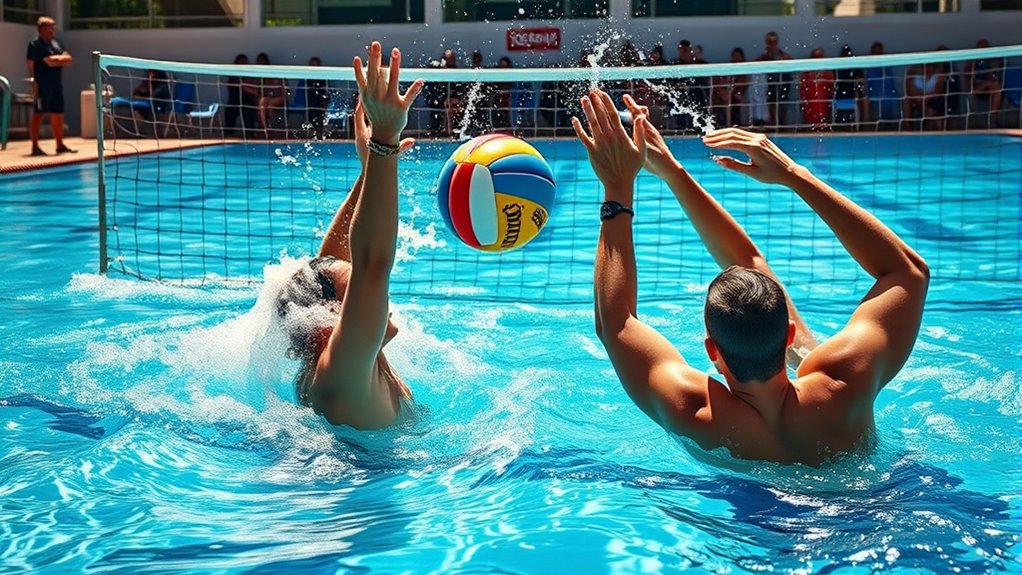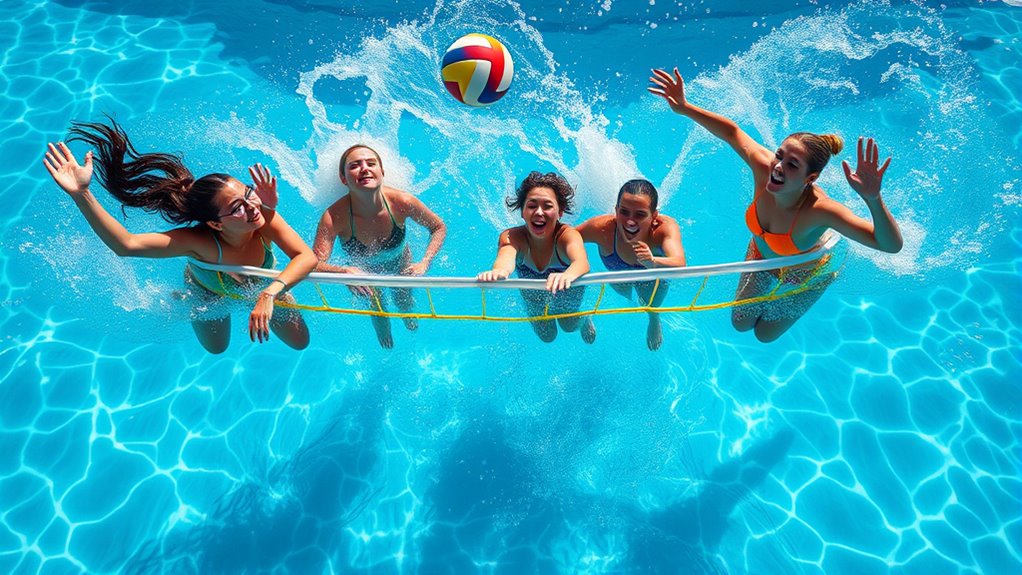To set up water volleyball, find a pool large enough to hold a floating net at about 7-8 feet high, adjustable for your space. Use boundary markers like ropes or cones and make certain the net stays afloat. The game involves quick, controlled hits, focusing on teamwork and strategy. Prioritize safety and practice to improve skills. Keep exploring to learn more about perfecting your water volleyball experience!
Key Takeaways
- Set up a floating net at 7-8 feet height, marking boundaries with ropes or cones for clear play lines.
- Use lightweight, buoyant ball designed for water play, ensuring safety and ease of handling.
- Play follows standard volleyball rules with modifications for water, such as water-based movement and control strategies.
- Teams hit the ball over the net with controlled, strategic hits, maintaining rally and avoiding faults.
- Prioritize safety, proper equipment setup, and fun, adapting rules and court layout to pool size and conditions.

Have you ever tried playing volleyball in the water? If not, you’re missing out on an exciting, challenging experience that combines the fun of volleyball with the revitalizing feel of being in the pool. To get started, understanding the basics of water volleyball setup and the right equipment is essential. Your water volleyball strategy will evolve as you become more familiar with how the game flows in this aquatic environment. First, you’ll need some water volleyball equipment, which typically includes a floating net, a lightweight ball designed for water play, and sometimes a boundary marker to define the court. The net should be sturdy enough to stay afloat and be adjustable for different depths, making it suitable for various pool sizes. The ball needs to be buoyant and easy to hit, so it won’t sink when struck underwater. Proper equipment ensures safety and enhances your overall experience. Additionally, considering the safety precautions specific to water sports can help prevent injuries and ensure everyone has a good time.
Once you have your water volleyball equipment ready, setting up the court is straightforward. Find a pool with enough space to accommodate your team and set the net at the appropriate height—usually around 7 to 8 feet for recreational play. The court’s dimensions can be adjusted based on your pool size, but a typical setup resembles a standard volleyball court, just in water. Mark the boundaries with floating ropes or cones if you want clear lines to help players judge their plays accurately. Now, before you plunge in, it’s good to develop a water volleyball strategy. Unlike traditional volleyball, the water adds a layer of complexity—timing, positioning, and movement are all affected by buoyancy. You’ll want to focus on quick, controlled hits and anticipate your opponents’ moves because the water slows down reactions and makes precise placement more challenging.
Mastering your water volleyball strategy involves communication, positioning, and understanding your team’s strengths. For instance, some players excel at quick taps near the net, while others are better at deep, powerful serves. Position yourself accordingly; stay low and keep your body balanced to move smoothly through the water. When you’re in the game, aim to keep the ball in play by using strategic hits that exploit your opponents’ weaknesses. Use your water volleyball equipment effectively—whether it’s a gentle set or a powerful spike—to keep control of the game. Remember, the key is to stay light on your feet, maintain good coordination, and have fun. With practice, your water volleyball skills will improve, and you’ll find yourself enjoying the game more with each round. So, gather your friends, set up your court, and get ready for a splashy, energetic game that’s as much about strategy as it is about fun.
Frequently Asked Questions
What Safety Equipment Is Recommended for Water Volleyball?
You should wear waterproof gear to stay dry and comfortable during water volleyball. Protective goggles are highly recommended to shield your eyes from splashes and potential impact. Consider using a water-resistant swimsuit and non-slip shoes to prevent slipping. These safety measures help you play confidently while reducing the risk of injuries. Always prioritize your safety by choosing appropriate gear, so you can enjoy the game without worries.
How Many Players Are Ideal for a Game?
You’ll want around six to eight players for a lively game, like a well-choreographed dance. This size keeps the action fast and guarantees smooth player rotation, preventing fatigue and keeping everyone involved. With a clear scoring system, every serve and spike counts, fueling the rhythm of the game. Too many players, and the court feels crowded; too few, and the game loses its spark. Aim for that perfect balance.
Can Water Volleyball Be Played Indoors?
Yes, you can definitely play indoor water volleyball. Just set up an indoor water volleyball court with a proper water volleyball court setup, including a pool or water-filled area. Make sure the space is large enough for players to move freely and the water level is appropriate. Indoor water volleyball allows you to enjoy the game year-round, regardless of weather, providing a fun and active experience indoors.
What Is the Typical Duration of a Match?
A typical water volleyball match lasts about 15 to 20 minutes, depending on the level of play and the number of sets. The game length is usually determined by the players or tournament rules, with matches often consisting of best-of-three or five sets. Keep in mind that the match duration can vary if teams are closely matched or if there are breaks between sets, but generally, it stays within this timeframe.
Are There Age Restrictions for Players?
There are generally no strict age restrictions for water volleyball, making it accessible for youth participation and players of all ages. Most leagues and recreational groups encourage everyone to join, but you should verify specific rules for your facility or league. Youth players often participate with adult supervision, and some competitions may have age limitations to ensure safety and fair play. Always confirm local guidelines before joining.
Conclusion
Now that you’re armed with the rules and setup tips, water volleyball becomes your playground of fun. Think of it as a splash-filled dance where every serve and volley keeps you moving and smiling. Jump in with confidence, and let the waves carry your game to new heights. Remember, it’s not just about winning—it’s about making a splash and creating unforgettable memories. So grab your friends and make every game a tide of laughter and joy!









